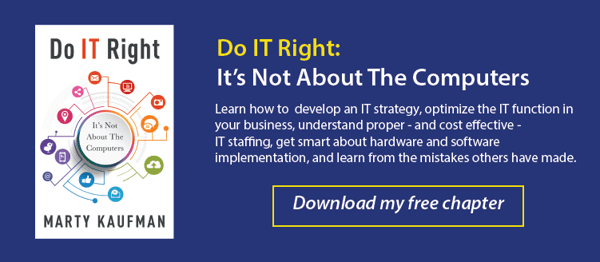Hi, I’m Kenny Riedell, Chief Technology Architect here at VC3. Today, let’s talk about one of the simplest ways to offload some of your critical IT processes to the Cloud. Software as a Service, or SaaS, is exactly what it sounds like. It's software that is hosted by a third party as a service with a recurring fee. To make things a bit easier to understand, we like to call this type of cloud offering “cloud services”.
Let’s dig in and discuss some factors to consider as you transition to cloud services including some of the unique challenges they can present for your IT team.
Watch the video or continue reading below.
First Steps with Cloud Services
Getting started with cloud services is a lot simpler than you may think. In fact, you may already be using some of them. If your business uses Microsoft Office 365, Dropbox, G Suite, or some other hosted email or collaboration tool then you are already utilizing Cloud Services. Migrating from on-premise email solutions to cloud-hosted email is one of the most common projects that we here at VC3 do for our clients.
Hosting your email in the cloud is a great way to improve the stability and reliability of your email system while also simplifying both management and licensing. This is also one of the most critical first steps to getting your business from using on-premise servers to a cloud hybrid infrastructure and finally, to a full cloud services solution. The reason for that lies in some of the additional features that the major cloud-hosted email providers include.
Controlling Access to Your Cloud Services
As you start to think about moving some of your business-critical applications to the cloud, you will most likely ask yourself how your employees will access those applications. Will they need a different password for each one? What about onboarding new employees? How do you restrict access when someone leaves the company? These are all great questions and most of them have a somewhat simple answer; identity management.
If you currently live in the Microsoft world, as most of us do, then your company most likely uses Active Directory to manage user accounts and their access to your systems and applications. This works great when all of your applications live on a box in your server room but having a cloud service authenticate users against your local servers is generally not feasible. This is where some of those additional features from your email provider come in handy.
Related: Learn about cloud services and consulting for Southern California organizations.
Both Microsoft Office 365 and Google’s G Suite provide their own directory of user accounts but more importantly, they support third-party authentication in a variety of ways. What this means is that you can utilize your cloud email host as an identity management service that almost every cloud service provider can integrate with. Users will only need one set of credentials to access all of your cloud services. While you are in a hybrid environment, you can (and should) take this one step further by synchronizing your Active Directory users and their passwords up to Office 365 or G Suite. This can all be a bit tricky to get set up but once it is, it works great!
Don't Lose Sight of Endpoints
Endpoint management is another feature of your on-premise servers that is often taken for granted and is generally forgotten about when planning a migration to cloud services. Your existing Active Directory servers not only manage the user accounts but they also keep track of the computers, or endpoints, and what policies are applied to them to give your employees a uniform experience. Once those servers are retired, you will need a new way to manage your company’s devices.
Again, both Office 365 and G Suite provide their own versions of endpoint management, often also mixed with or referred to as Mobile Device Management (MDM). There is also a slew of third-party MDM, identity management, or Directory as a Service providers out there to choose from. While it is typically best to keep things simple and use the solution that your email provider offers, your company may have special requirements. Your IT team should review the different options for endpoint management with you and help you choose the right one.
Make sure to check out the rest of this three-part series where we talk about the different types of cloud offerings and talk about cloud servers, or IaaS, the other main cloud option in depth.
Cloud Consulting
You don't have to be an IT expert to make the wise decisions about cloud computing when you have an IT business partner like VC3 on your side. Give us a call today and explore how you can get ongoing technology consulting while dramatically improving your IT experience.
Get in touch here, call us at 800-481-4369 or move on to part 3 of this series.


